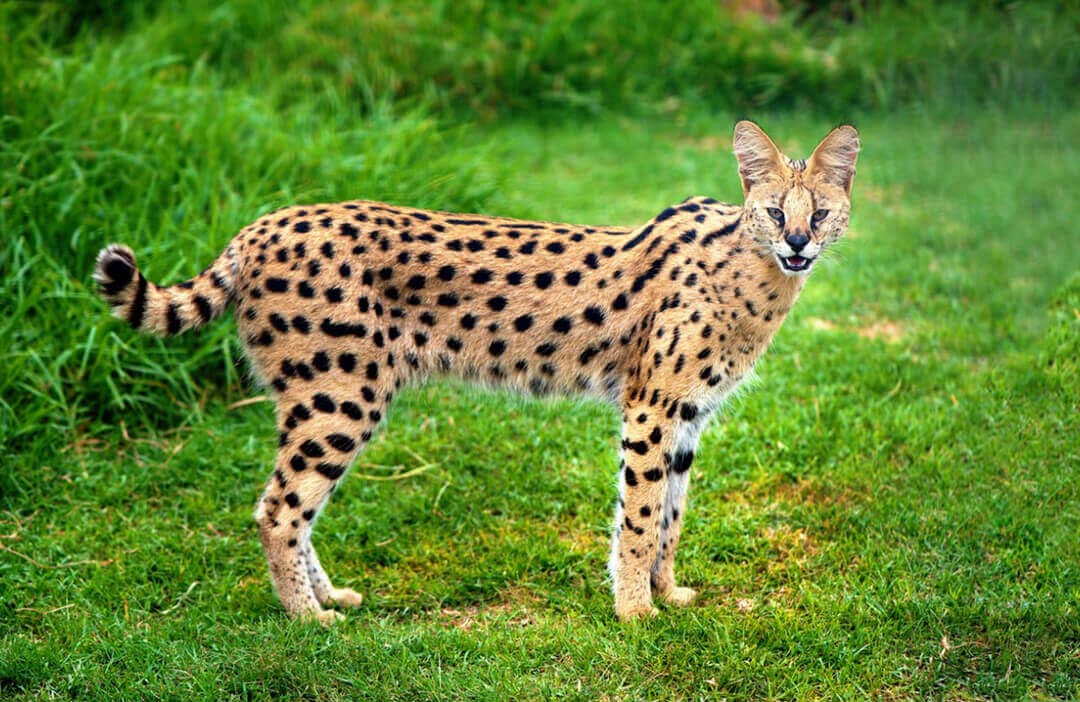African hunts generally conjure images of large game animals like the lion, elephant, buffalo, and kudu. But there are alternative (and equally exciting) targets on the plains. Serval hunts offer a different side of the African hunting safari, putting hunters on the path of an animal that too can be an elusive, exciting, and challenging hunt.
[DYNAMIC-BLOGTABLEOFCONTENT]
Key Takeaways
- Serval hunting offers a unique hunting safari experience and the chance to own a beautiful and special trophy.
- The serval are highly athletic animals with skills including speed, leaping, and even tree climbing.
- Like their cat cousin the leopard, serval are solitary creatures and can be active throughout the day and night.
- South African hunts for serval are available in a choice of provinces, as well as other hunting destinations in Africa.
- Serval can be hunted through various means, including rifle and hound hunts.
About the Serval: A unique Trophy on an Africa Hunt
Africa’s cats are traditionally seen as large and in charge, but the increased popularity of serval hunting shows that size doesn’t always matter as much when choosing a memorable hunting experience.
Appearance
It can be argued that the serval is a true athlete in the physical sense. Serval are athletic and medium-sized felines that stand around 20–24 inches high, weighing in at between 20-40 pounds depending on gender and maturity. A fun fact is that the serval has the longest legs-to-body size comparison of all the wild cats, and when combined with longer feet and toe structures, the serval has a graceful and highly athletic appeal to it.
As with most species, the males tend to be bigger and “sturdier” than their female counterparts. Females tend to be lighter in mass and stand a bit lower with a shorter body length. Both genders are characteristically known for their smaller head and almost comically larger ears, with a coat that varies from a brown-yellow buff shade to golden tones and even a slight orangey-brown tint. What brings the true character to their appearance (apart from the ears) is their spotted markings. These markings and spots show broad variations in size, location, and pattern. Commonly, the serval is known for the black ears with a white band, a white or paler color chin and cheek area, and 3 to 4 rows of black “striping” that run from the head down the shoulders and onto the back. Their belly is light to almost white and their fur is thick with its length varying across the body; being the longest and fluffiest on the belly and tail base.
Special skills and abilities
The skills possessed by this feline, are often the ones that can challenge and complicate when hunting serval in their natural environment. These cats may be small, but thanks to their long legs and lithe bodies they can reach speeds of almost 50 MPH and leap up to 10 feet in the air. When leaping across the ground at a prey target, the serval can cover up to 15 feet in a jump. Serval can turn their ears 180 degrees using the 22 muscles of their ear structure, these impressive appendages allow serval to even track prey underground.
Serval Behavior: Characteristics, Reproduction, and Attitude
Similar to leopards, servals are solitary by nature and both males and females create “home ranges” which they mark through their droppings, urine spraying, and rubbing their face on vegetation to mark it with scent from their saliva. Servals are diurnal in the sense that they are active during both day and nighttime hours with peaks of activity around sunrise, sunset, and midnight hours when the environment is cooler. Servals are territorial of their ranges, but rivals rarely escalate to fighting; instead, they show displays of dominance or go out of their way to avoid interacting with other servals completely…elective loners if you will.
Female servals are known to reproduce 2 to 3 times a year, but should these litters not survive, they can reproduce up to 4 times a year. Females in heat will increase the spraying of urine as both a marker of territory and to call males, salivate more than usual, and call out in sharp and short meowing sounds. Serval gestation lasts around 2 to 3 months and typically litters can range from just one to four kittens that are blind at birth with almost woolly fur and no black markings. Females give birth in secluded areas, often taking over abandoned burrows. The bonding relationship between a mother and a cub lasts around a year, from this point on the cubs are seen as mature enough to lead their own lives.
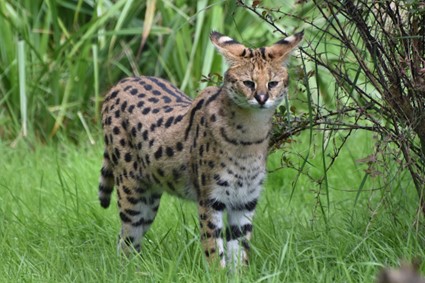
Where do Serval fit in?
Servals are carnivores and prey on small birds and reptiles as well as hares, rodents, birds, and even frogs. When it comes to larger prey, serval enjoys taking down waterfowl, antelope such as the duiker, and even the young antelope of larger species. They are also known to consume grass and vegetation as a way of aiding digestion or inducing vomiting should they eat something potentially poisonous or dangerous.
The felines employ their great sense of hearing when hunting, and once a desired target is found they can stand motionless for up to 15 minutes waiting for their prey to be within striking range. When it comes to smaller prey, the serval launches an attack leading with the front legs, jamming the prey on the ground before using quick bites to the neck and head to finish them off. Birds and larger prey are sprinted after and leaped at, either plucking them out of the air or bringing the animal to the ground where the neck and head biting is used again. Serval are known to consume snakes while they are still alive and moving.
When it comes to animals that prey on serval, their biggest foes are hyenas and wild dogs. To escape their chasers; serval use their long legs to sprint off in athletic leaps, frequently changing their direction. Like other cats, serval are decent tree climbers and can charge over 30 feet up a tree to evade their potential captors.
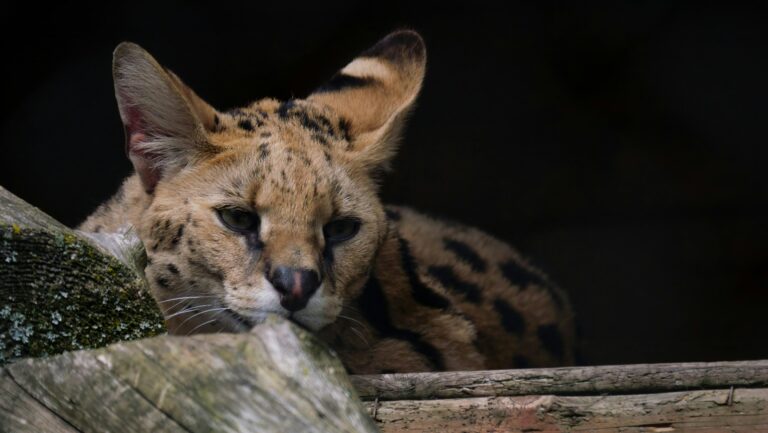
Where to go when Hunting Serval: Destinations and Requirements
Serval cats can be found across Africa in almost any biome, except wet grassland regions. The most common and best-serving areas of serval African hunts are given below, some African countries like Mozambique do not allow any small cat or serval hunting at all.
Serval hunts in South Africa
The “gateway to Africa” is known as a golden spot for almost all hunting safari adventures, so serving up four areas known for serval hunts can’t be too surprising. It’s worth noting (and remembering) that each province in South Africa can have independent regulations when it comes to hunting, so it’s worth contacting your outfitter to ensure you have the correct plans and permits in place before starting your hunt.
South African hunts for serval can be found in:
Mpumalanga
Like much of Mpumalanga’s big game hunting safari options, hunting serval in Mpumalanga generally takes place in the Lowveld region of the province. This region is known for a flat terrain that’s subtropical savanna-like in nature with a real Bushveld feel.
Due to the Lowveld’s flat and wide-open landscape, the wind can pose an irritation, especially when tracking and walking through the area.
Limpopo
Known as the hunting mecca of South African hunts, Limpopo offers more than just the big game boys. Serval are available on many a game farm (alongside other small game); and with Limpopo being home to a large majority of South Africa’s private game ranches, the biggest choice will be choosing the farm.
Bordering Mpumalanga to the South, Limpopo too has a vast Lowveld/Bushveld region where serval hunting is plentiful and good trophies abound.
Kwa-Zulu Natal
A province wedged between the Indian Ocean and the Drakensberg Mountains; Kwa-Zulu Natal is home to a diverse landscape stretching from coastal wetland to rainforest. So where would one most likely plan their serval hunting? Between the Natal Midlands region and Zululand, lies a transitional area of Bushveld home to both serval and their prey, a region known for its free-range game.
Free State
A flat province home to around 70% of South Africa’s maize production, its grassland territory provides opportunities for hunting serval and many other game species. A supporter of the serval population is many waterfowl, birds, and rodents that form part of the primary prey for serval.
Namibia
Serval hunts in Namibia are generally found in the northeastern region of the country with these felines avoiding the forest and arid desert regions. This region is home to the famous game hunting destination the Caprivi Strip, where rivers like the Okavango and Zambezi serve as a vital life source for those in the almost tropical savanna area.
Zimbabwe
Found across the country, but especially along Zimbabwe’s central plateau, the serval prefers this habitat devoid of the larger and more dominant game animals. Here the serval finds itself with available and sustainable food sources, water, and shelter provided by the thick grassland or woodland areas.
Due to the classification of Zimbabwe’s hunting areas, the rules of serval hunting are not the same, and it’s worth checking in with your outfitter to be sure of what to expect.
Tanzania
The jewel of the African hunts destinations, Tanzania is home to its own unique subspecies of serval known as the Tanzanian serval or Ukamba serval. Serval hunting in Tanzania generally takes place in the southern regions, particularly in the renowned Selous Game Reserve where 3 of the country’s rivers draw wildlife to the area.
Serval have been spotted around the Ngorongoro Conservancy region in Tanzania’s northern volcanic territory, but better hunting safari opportunities are found in the south.

Serval Hunting: Methods and Suggestions for an Alternative Hunting Safari
While serval don’t fall under the big game category and aren’t easily classified as African plains animals; they can be hunted using a blend of the methods traditionally used for other game hunting targets. Serval hunts can be mentally challenging, and demand quick responses coupled with keen spotting abilities.
Hunting Serval: How to Track, Locate, and Catch Your Cat
The old faithful hunting safari method of spot and stalk is traditionally used when serval hunting is the goal. A challenge with this is that servals have an extremely fine-tuned sense of hearing, which apart from allowing them to find prey underground, also enables them to hear the approach of the game hunters long before they become visible.
A variant of this is to employ the serval’s own hunting go-to of “still hunting”. Much like spot and stalk, the main difference is the pauses (or stills) used when tracking the animal. If a serval can hold its position for almost 15 minutes stalking its prey, the same could be required of the hunter stalking their target.
The use of hounds on serval hunts is allowed, but this is solely dependent on the destination and classification of the hunting safari land used.
The Tools of the Trade for a Serval Hunting Safari
Serval hunting, like with other small predator/game adventures, can be done with any.22 caliber rifle and a decent scope for medium-range usage. Some serval shots may be taken while the animal is in movement, so confidence in your aim and firing ability is also required.
Shot Placement for Serval Hunts
As with other cat species, the heart and lungs are the desired target points when making the shot. The heart is found behind the foreleg, with the lungs aligned along the midway line of the body. When standing at a right angle to the target, an “easy” way to determine this is to divide the body in half, and then in half again, the heart falls along the lowest dividing line.
If facing the serval head-on, a shot to the center of the chest where the neck and body join is a good option. A less likely shot is when facing the target’s back, this requires a precision shot to the base of the tail, a shot that is not often recommended.
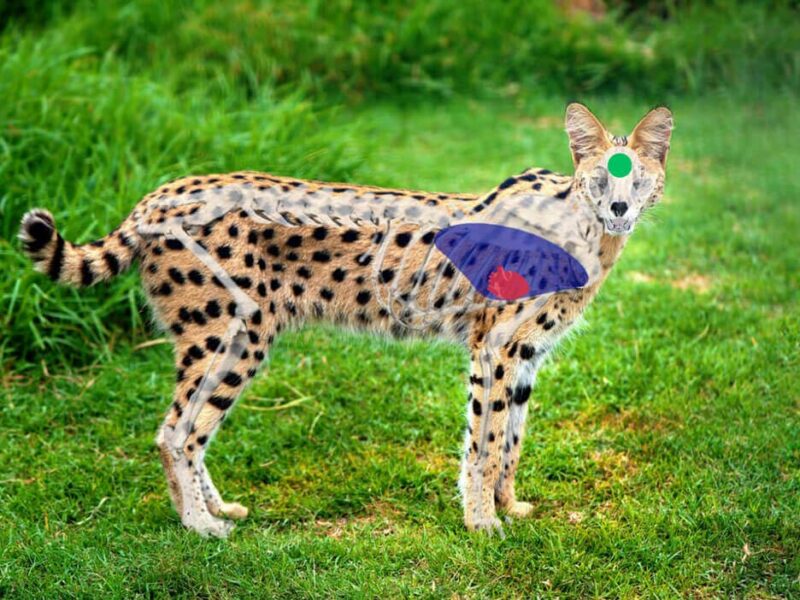
Things to Remember on these African Hunts
Across the board, serval hunting requires its own special permit. While the hunt itself is seen as opportunistic, taking a shot at a serval who happens to cross your path is illegal and can result in fines or other punishment. African hunts are highly regulated in general and complying with the stipulated laws is seriously suggested. South Africa requires a TOPS permit alongside the hunting license for any serval hunting and trophies.
Serval hunts with hounds are available and require their own special license; these types of hunts can be found in South Africa and the private hunting safari ranches of Zimbabwe. These hunts use trained dogs to sniff out and chase the target, adding a level of excitement and old-world appeal.
Night serval hunting is available on South African hunts and Zimbabwean hunts only. These types of hunting safari require a supplementary permit and in the case of Zimbabwe; further permission from the land owner as not all hunting areas allow night hunting, even though it is legal on private land.
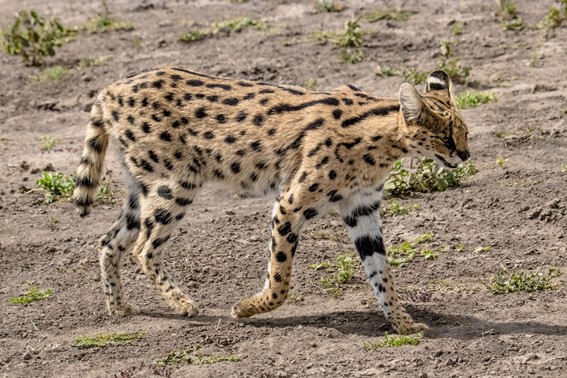
Frequently Asked Questions
Are servals difficult to hunt?
Are servals aggressive?
No, they are not known to be aggressive towards people.
What is the lifespan of a serval?
Servals generally live 10-12 years in the wild and can live more than 20 years in captivity,
What is the top speed of an African serval?
Servals can reach up to 50 miles per hour, with its long legs helping to achieve this impressive speed. This speed is very necessary when targeting its prey that includes rodents, hares, insects, and birds.
Do lions eat serval cats?
While lions are not the primary predator for servals, they do eat them should the opportunity arise. Servals are hunted by hyenas, African wild dogs, leopards, and martial eagles, while serval kittens are targeted by honey badgers, birds of prey, mongooses, and snakes.
What is the Attraction of Serval Hunts?
Serval hunting is often seen as a way for the hunter to “complete” their collection of African cats. An accessory species if you will, the serval makes for a beautiful trophy that compliments those alongside it. These hunting safari opportunities carry a uniqueness, something hunters pursue as a further measure and seal of approval on their hunting careers and abilities.
Hunting serval is an experience that should be enjoyed by both serious and “casual” hunters alike. These small cats offer a good trophy prospect and can be found in a destination and difficulty level to suit almost every budget and preference.
So, while the Big 5 and big African plains game animals shine brightest; the smaller stars of the African hunts showcase shouldn’t be sneezed at, so take on the (smaller?) challenge and see where the tracks lead you!
Author: A. Baker
